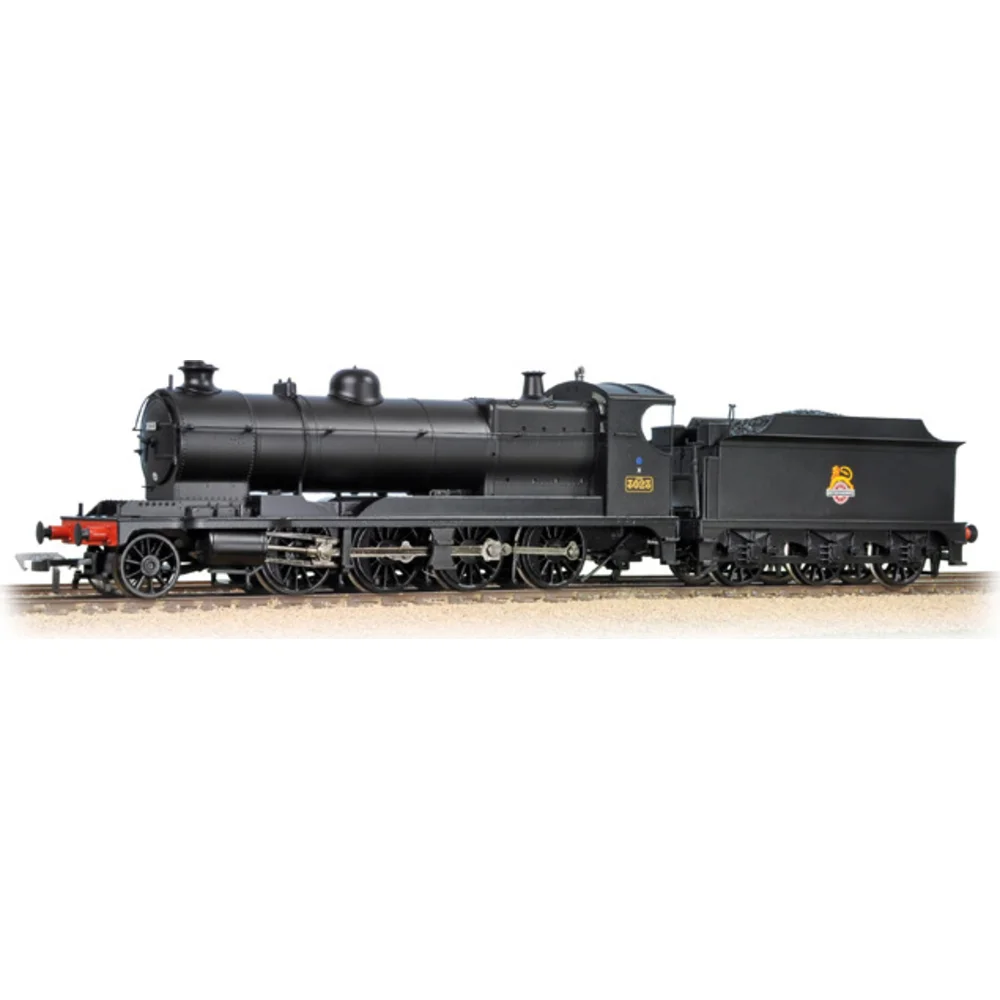Bachmann 31-127
Great Western Railway 3000 3023 British Railways Black with Early Emblem
Tooling
The Bachmann Branchline GWR 3000 Class 'ROD' 2-8-0 was first announced in 2011 as part of a broader programme of new tooling and upgrades. This model represents the ex-Railway Operating Division (ROD) heavy freight locomotives that were absorbed into Great Western Railway service post-WWI. The tooling was developed to reflect the robust and utilitarian nature of these wartime engines, which were based on the Great Central Railway Robinson 8K design.
Tooling Features
- Scale: OO Gauge (1:76)
- Construction: Die-cast chassis with plastic body shell
- Detailing: Finely moulded pipework, separately fitted handrails, brake rigging, and tender detailing
- Couplings: NEM pockets with tension lock couplers
- Finish: Offered in both pristine and weathered finishes
Mechanical & Electrical
- Motor: Centrally mounted motor driving the locomotive’s driving wheels
- Drive: All-wheel drive with pickups on both locomotive and tender
- Minimum Radius: Suitable for second radius curves (438mm)
- Lighting: No directional or interior lighting fitted
- Weighting: Adequately weighted for reliable traction and haulage
DCC Capability
- DCC Ready: 21-pin MTC socket located in the tender
- Sound: Space and speaker connections provided for aftermarket sound decoder installation
Liveries Produced
- GWR Green with "Great Western" lettering (e.g., No. 3031, No. 3028)
- BR Black with Early Emblem (e.g., No. 3023, No. 3036)
Reviews & Commentary
- Sam'sTrains Review: Praised the model for its smooth running and value for money, especially in DCC operation. Watch the review.
- User Feedback: eBay reviews consistently rated the model highly for quality and performance, especially among GWR modellers.
Additional Notes
- Some early models experienced DCC wiring issues, which were later corrected in subsequent production runs.
- The tooling was part of Bachmann’s effort to expand its heavy freight locomotive offerings and fill a gap in WWI-era British motive power.
The Bachmann GWR 3000 'ROD' tooling remains a popular choice for modellers interested in wartime and early BR freight operations, offering a blend of historical significance and solid performance.
Class & Prototype
- Class: Great Western Railway 3000
- Traction: Steam
- Built: 1911
- Total Built: 100
No prototype found.
Operator & Livery
- Operator: British Railways
- Livery: Black with Early Emblem
British Railways transformed Britain's fragmented rail network into a unified national system following nationalisation on 1st January 1948. Created from the "Big Four" companies under the Transport Act 1947, BR operated most of Great Britain's railways until rebranding as British Rail in 1965, managing over 20,000 route miles and inheriting nearly 20,000 locomotives of diverse designs.
The organisation pioneered standardisation through its revolutionary BR Standard locomotive programme (1951-1960), producing 999 advanced steam engines under Robert Riddles' direction. These included the versatile Britannia Pacifics, mighty 9F freight engines, and mixed-traffic classes that incorporated the best features from all predecessor companies. The 1955 Modernisation Plan accelerated diesel and electric traction development, creating fascinating mixed-traction operations.
Notable achievements included establishing unified locomotive classification systems, introducing distinctive corporate liveries, and managing the complex transition from steam to modern traction. BR's six regional structure preserved operational diversity whilst enabling standardisation of practices, signalling, and rolling stock that had eluded private enterprise for over a century.
The BR era represents steam traction's final flowering alongside emerging diesel technology, creating unparalleled locomotive variety. Today, this heritage remains highly popular with railway enthusiasts through extensive preserved fleets, heritage railway operations, and comprehensive model ranges from manufacturers like Hornby, Bachmann, and Dapol, making BR subjects essential for authentic post-war British railway modelling across all scales.
British Railways' plain black livery was designated specifically for freight and shunting locomotives from 1948, representing the most economical and practical finish for inherently dirty industrial machines. During the early nationalisation period, many locomotives were simply patch-painted over old company markings with black paint, which quickly weathered to match the existing finish as these engines were rarely cleaned. The "Lion and Wheel" emblem (nicknamed the "Cycling Lion") was introduced from December 1948 and applied to plain black locomotives from early 1949, featuring a lion standing over a large railway wheel with "British Railways" lettering across the centre.
The emblem was produced in three sizes and always faced forward, positioned centrally on tender sides or tank sides, with regional preferences evident—the Western Region favoured larger emblems whilst other regions used smaller versions. Plain black locomotives retained red buffer beams and received white "BRITISH RAILWAYS" lettering in Gill Sans style before the emblem's introduction. Some former company locomotives, particularly ex-GWR shunting engines, retained their original lettering well into the early 1960s as they didn't require renumbering and received minimal attention. This utilitarian livery remained standard for freight operations until the mid-1950s emblem change, making it essential for authentic early BR period modelling of goods yards, collieries, and industrial operations.
